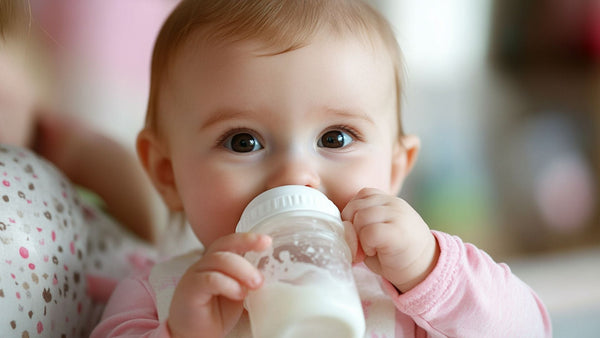How To Get Baby To Sleep
25 hours of research 4 minute read

Bringing a newborn into the world is a joyous occasion, but the quest for a good night's sleep can often become a daunting challenge for new parents. Understanding your baby's sleep patterns and creating a safe sleep environment are essential steps in ensuring both you and your little one get the rest you need. In this comprehensive guide to “go to sleep little baby”, we'll provide you with valuable insights, practical tips, and trustworthy sources to help you navigate the world of infant sleep.
Understanding Baby Sleep Patterns
Newborn Sleep Patterns
Newborns are notorious for their unpredictable sleep patterns. While they spend a substantial amount of time sleeping, usually between 16 to 18 hours a day, it's broken down into short 2-4 hour stretches. Here's what you need to know:
Varied Sleep Duration: Newborns sleep anywhere from 8 to 18 hours per day. The exact amount varies among infants. Don't be alarmed if your baby's sleep duration doesn't match others; babies have unique needs.
Frequent Interruptions: Newborns typically sleep in 2-4 hour periods, which are often interrupted by feeding, diaper changes, or fussiness. This can leave parents feeling exhausted as they attempt to keep up with their baby's needs.
Changing Factors: Sleep patterns can change due to various factors such as growth spurts, teething, and illnesses. It's important to remain flexible and responsive to your baby's evolving sleep requirements.
Emerging Consistency: While the initial weeks may seem like a blur of sleepless nights, more consistent sleep patterns tend to emerge around the 3-month mark. This is a significant milestone as it allows parents and babies to settle into a more predictable routine.
Establishing an Infant Sleep Schedule
Understanding your baby's evolving sleep schedule is crucial for maintaining your own sanity and ensuring your baby gets the rest they need. Here's how you can navigate this journey:
- Day and Night: Infants initially struggle to distinguish between day and night. To help, expose your baby to natural light during the day and keep the environment dark and quiet during nighttime feedings and changes.
- Longest Sleep Stretches: Surprisingly, the longest sleep stretch for your baby may occur during the day. Don't be alarmed; this is perfectly normal. As the days and nights blend together for your baby, be prepared for frequent waking during the night.
- Frequent Waking: Remember, frequent waking is entirely normal for newborns. It's their way of ensuring they're fed, comfortable, and secure. Be patient and responsive to your baby's needs during this time.
- Matured Sleep: By 3-6 months, you can expect longer sleep periods as a sign of their maturing brain and body. At this point, you can start working on establishing more consistent sleep routines and schedules.
Creating a Safe Sleep Environment

When it comes to your baby's well-being, creating a safe sleep environment is paramount. Providing a secure and comfortable sleep space is not only essential for their health but also for your peace of mind. Follow these guidelines:
Dedicated Sleep Space: The safest place for your baby to sleep is in their own dedicated sleep space, such as a cot or a Moses basket. This space should be clear, flat, and separate from any potential hazards.
Room-Sharing: It is recommended that you room-share with your baby for at least the first six months of their life. This practice has been shown to reduce the risk of Sudden Infant Death Syndrome (SIDS). Having your baby nearby allows you to respond quickly to their needs during the night.
Back to Sleep: Always place your baby on their back to sleep. This position significantly reduces the risk of SIDS. Ensure that caregivers and anyone putting your baby to sleep also follow this guideline.
The Right Mattress: Use a firm, flat, waterproof mattress in your baby's sleep space. Avoid any mattresses with raised or cushioned areas, as they can pose a suffocation risk.
Avoid Non-Designated Sleep Spaces: It's important to avoid using swings, baby bouncers, or sleep pods as sleep spaces for your baby. These items may not provide the safe and flat surface necessary for proper sleep.
Transition from Pram or Car Seat: If your baby falls asleep in a pram, car seat, bouncer, or carrier, it's crucial to transfer them to their designated sleep space when you return home. These devices are not designed for extended sleep, and leaving your baby unattended in them can be risky.
Essential Baby Sleep Products
Here's a list of essential baby sleep products, to create a safe sleep environment for your baby.
Cot or Moses basket: Your baby's dedicated sleep space is the foundation of their safe sleep environment. Ensure it meets safety standards and provides ample room for your baby to sleep comfortably.
Portable sleep space: Portable sleep options like a Moses basket, travel cot, or carry cot allow you to keep your baby close, whether you're at home or on the go.
Mattress: Invest in a firm, flat, waterproof mattress that fits snugly in your baby's sleep space. It should be free of any gaps or raised areas.
Sleeping bag or blankets: Keep your baby comfortably warm by using a sleeping bag or swaddle blankets that are designed for safe sleep. Avoid using loose blankets that can pose a suffocation risk.
Baby Sleep Pillow: Discover the benefits of using a baby sleep pillow as as baby sleep aid to provide additional comfort and support during naptime or nighttime sleep. While soft bedding is generally not recommended for babies, you can introduce a flat, firm baby sleep pillow designed for safe sleep. Always follow guidelines to reduce the risk of Sudden Infant Death Syndrome (SIDS).
Sheets: Use fitted sheets that fit the mattress securely, ensuring a smooth and secure sleep surface for your baby.
Room thermometer: A room thermometer helps you maintain a comfortable and safe sleeping temperature for your baby. The recommended room temperature for a baby's sleep environment is around 68-72°F (20-22°C).
Products to Avoid
For the safety of your baby, avoid the following products:
Pods or nests: These can pose a suffocation risk and should not be used in your baby's sleep environment.
Pillows, duvets, or thick, heavy bedding: These items can increase the risk of SIDS and should not be used in your baby's sleep space.
Cot bumpers: Cot bumpers can pose a suffocation risk and should be avoided.
Hammocks: Avoid using hammocks for your baby's sleep, as they can be unsafe and do not provide a flat sleep surface.
Sleep positioners: These are unnecessary and can pose a suffocation risk. Your baby should be allowed to find a comfortable sleep position on their own.
Transitioning from Bassinet to Cot
Transitioning your baby from a bassinet to a cot is a significant milestone. Follow these tips for a smooth transition:
- Start slowly by having your baby take daytime naps in the cot to get used to the new environment.
- Keep the cot consistent with the bassinet by transferring bedding, mobiles, or lullaby music.
- Maintain the same lighting, temperature, and noise levels as your baby's previous sleep space.
- Stick to your baby's regular bedtime routine to signal sleep time, regardless of the change in surroundings.
Co-sleeping vs. Independent Sleep

Co-sleeping can be a wonderful bonding experience, but it's essential to follow safety guidelines:
- Never co-sleep if someone has consumed alcohol, smoked, or taken drugs or medication that causes drowsiness.
- Co-sleeping is not recommended for premature babies or those with a birth weight under 2.5kg.
- Ensure safer co-sleeping by keeping adult bedding and pillows away from the baby, placing them on their back, and avoiding other children or pets in the sleep space.
Creating a Sleep-Friendly Nursery and Soothing Baby at Bedtime
A calming bedtime environment and soothing techniques can make a significant difference in your baby's sleep quality:
- Keep the nursery dimly lit or use a nightlight for a soothing atmosphere.
- Use a quiet voice and limit conversations during bedtime.
- Put your baby down to sleep before they become drowsy to encourage independent sleep.
- Avoid overstimulation before bedtime.
- Establish a consistent bedtime routine, including a warm bath, baby massage, a bedtime story, and a lullaby.
Calming a Fussy Newborn
Try these techniques to soothe your baby:
- Replicate the womb's familiar environment.
- Swaddle your baby and use white noise to mimic the snug feeling and sounds of the womb.
- Gentle car rides or rocking can help calm your baby.
- Stroking their back, massaging, and cuddling provide comfort.
- If persistent fussiness occurs, check for hunger, discomfort, or illness.
Addressing Feeding and Sleep Associations
Babies often associate certain actions, like feeding, with comfort and sleep. To encourage self-soothing:
- Gradually introduce other comforting routines, such as gentle rocking or lullabies, alongside feeding.
- Over time, your baby will learn that sleep can come without always being fed, improving their sleep habits.
Popular Formulas To Help With Baby Sleep
Creating a safe and comfortable environment is key to getting your baby to sleep soundly, and the right formula can play a significant role in promoting restful sleep. Nutrition affects everything from your baby’s mood to their ability to sleep through the night. To help you in your journey, we’ve highlighted three popular formulas known for their high quality and benefits that can contribute to better sleep for your baby. Many parents find that choosing one of these popular formulas supports their baby’s growth, development, and ability to sleep well. Each of these options is designed to promote comfort and reduce nighttime disturbances, helping your baby sleep soundly and making your home a more peaceful place.
✓ 100% Organic formula
✓ With Added Prebiotics and Probiotics
✓ HiPP's most popular formula
Check PricePopular With Parents Because: HiPP Dutch formula is highly regarded among parents for its premium organic ingredients and gentle formulation. Sourced from biodynamic farms, this formula is designed to be easy on your baby’s digestive system, reducing the chances of nighttime discomfort that can disrupt sleep. Rich in essential vitamins and minerals, HiPP Dutch ensures your baby receives balanced nutrition, supporting overall health and well-being. The inclusion of prebiotics and probiotics in HiPP Dutch also promotes a healthy gut, which can contribute to better sleep patterns by minimizing digestive disturbances.
✓ Demeter certified (Organic++)
✓ Easy-to-digest Goat Milk Formula
✓ Popular for babies with sensitivity to cow's milk
Check PricePopular With Parents Because: Holle Goat Dutch formula is an excellent option for babies with sensitivities to cow's milk, which can sometimes cause fussiness and sleep disturbances. Made from organic goat's milk, this formula is easier to digest and less likely to cause allergic reactions, helping to ensure a smoother feeding experience and more restful sleep. Holle Goat Dutch is packed with essential nutrients, vitamins, and minerals that support healthy growth and development. Its gentle composition can help reduce nighttime irritability and discomfort, promoting a more peaceful sleep environment for your baby.
✓ Contains Milk Fat Globule Membrane (MFGM)
✓ Vegetarian-friendly (Contains Plant-Based DHA and ARA)
✓ EU and British Soil Association Certified Organic
Check PricePopular With Parents Because: Kendamil Organic formula is a standout choice due to its 100% organic composition and commitment to using high-quality ingredients. Produced in the UK, Kendamil Organic uses whole milk and avoids palm oil and fish oil, making it a sustainable and ethical choice. This formula is rich in essential fatty acids, vitamins, and minerals, providing comprehensive nutrition that supports your baby’s overall health. The natural and wholesome ingredients in Kendamil can help create a calming feeding experience, contributing to better sleep by minimizing potential digestive issues that can disrupt rest.
Sleep Training Methods
Sleep training can be effective for older infants, typically over 6 months old. Here are some methods to consider:
- Cry it Out Method: This approach allows your baby to cry without immediate comforting. However, it's essential to ensure your baby's basic needs are met and that they are safe before trying it.
- Ferber Method: Similar to the Cry it Out Method, but it involves periodic checks to provide reassurance to your baby.
- The Chair Method: Gradually move away from your baby's cot each night, allowing them to become more independent sleepers.
- The Fading Method: Adjust your baby's bedtime gradually until you find a routine that helps them drift off peacefully.
Managing a Sleep Regression
Sleep regressions are a common part of a baby's growth journey. Here's how to handle them:
Understanding Developmental Changes Affecting Sleep
- Milestones like crawling, walking, and babbling can disrupt your baby's sleep.
- Introducing solids and teething may also disrupt their sleep routine.
- Remember that these changes are a natural part of your baby's growth.
Coping Strategies During Regression Phases
- Maintain consistency in your bedtime routines.
- Adjust nap times if necessary.
- Provide extra comfort when needed, such as additional cuddles or lullabies.
- Seek support from fellow parents, as you're not alone in facing sleep regressions.
- Keep in mind that sleep regressions are temporary phases and will eventually pass.
Essential Topics on Putting Babies to Sleep
Sleep Clothing for Babies
- How to Dress Baby for Sleep
Choosing the right sleep attire for your baby is crucial for their comfort and safety. Opt for sleep sacks that keep them warm without the risk of loose blankets.
- Dressing Baby for Sleep
Navigating the multitude of baby sleepwear options can be overwhelming for parents and caregivers. To ensure the safest choice for a baby's sleep, consider the following tips:
- Optimize Sleepwear Quantity: Given the rapid growth of babies, having a modest collection of four to six pieces of sleepwear is generally sufficient. This ensures a clean and dry option is always available for bedtime.
- Choose Convenient Designs: Look for gown-like sleep clothing with easy access at the bottom. This design facilitates quick and hassle-free changes, especially during nighttime diaper changes.
- Prioritize Light Layers: Opt for multiple thinner layers rather than heavy sleepwear. This approach allows for easier adjustment to the bedroom temperature, reducing the risk of overheating.
- Ensure Safety: Steer clear of attaching any items, including pacifiers, to a baby's clothes to avoid the risk of accidental strangulation. Remove loose buttons and small objects from clothing to prevent choking hazards.
Transitioning Sleep Spaces
- Baby Won't Sleep in Bassinet
If your baby is resistant to sleeping in a bassinet, consider gradual transitions and familiar elements to ease the change.
- Baby Won't Sleep in Crib
Addressing challenges when your baby refuses to sleep in a crib requires patience and consistency. Learn how to make the crib a comfortable and appealing sleep space. Addressing crib aversion may involve making the crib a more inviting space. Add familiar items, maintain a consistent bedtime routine, and ensure the crib is free of any discomfort-inducing elements.
- Baby Won't Sleep Without Swaddle but Rolls Over
Navigating the transition from swaddling to independent sleep can be tricky. Find strategies to ensure your baby's safety while accommodating their changing sleep preferences. Use a sleep sack or a transitional swaddle to give your baby a sense of security while allowing them the freedom to roll over.
Overtired Baby and Sleep Issues
Why Does My Baby Fight Sleep?
Understanding the reasons behind your baby's sleep challenges is key to addressing them effectively. Here are common factors that may contribute to your little one fighting sleep:
- Overtiredness: Missing the ideal sleep window can lead to overtiredness, causing irritability and difficulty settling down. Recognize your baby's cues for fatigue to avoid this.
- Not Tired Enough: Occasionally, your baby may resist sleep because they're not tired enough. This could be due to changes in their nap duration or a natural shift in sleep needs as they grow and develop.
- Overstimulation: Just like adults benefit from a calm environment before bedtime, babies can be overwhelmed by noisy toys, loud music, or excessive play. Create a soothing atmosphere to help them unwind.
- Separation Anxiety: If your baby has been clingy during the day, they might resist sleep due to separation anxiety. This common phase, often occurring between 8 to 18 months, can make them hesitant to be alone at bedtime.
- Circadian Rhythm Development: Infants start developing their circadian rhythms around 6 weeks, with a more established sleep schedule emerging between 3 to 6 months. Understand that each baby progresses differently, and some may take longer to establish a consistent sleep routine.
- Hunger: Growing babies require ample nourishment. Ensure your baby is getting the appropriate number of feedings based on their age, intake at each feed, and whether they are breast or bottle-fed.
- Illness: Discomfort from illnesses like ear infections or colds can disrupt your baby's sleep. Monitor for additional symptoms of illness and provide extra comfort during these times.
How to Get an Overtired Baby to Sleep
Discover tips to soothe an overtired baby and establish a calming bedtime routine to prevent exhaustion.
1. Remove Anything That May Be Causing Stimulation
Lights, loud noises, and being around a lot of people will distract baby, making it harder for him to relax and fall asleep. You will need to retreat to a quiet, dark room so that your baby can begin to relax and get ready for bed. This is one of the best approaches for how to calm an overtired baby.
2. Do a Calming Wind-Down Activity
If baby is hyper, doing a soothing wind-down activity may be your best bet. You know your child the best, so give him a toy that he really likes that doesn’t make noise or light up.He can play cuddles with his teddy bear, you can sing a soothing song with him, or let him chew on his favorite teething ring…the possibilities are pretty much endless but your main goal is to try to get him to focus on one thing that calms him.
3. Warm Bath with Products that Contain Lavender
During baby’s actual bedtime, you should consider bathing him with products that contain lavender.
Lavender produces calming sedative effects which can help baby relax and encourage him to sleep. Studies have shown that lavender can actually slow the activity of the nervous system resulting in better sleep, improved mood and lower stress levels.
4. Give Baby a Massage
One of the most underrated techniques I’ve found is baby massage. When done properly, massaging your baby can relax and soothe him which is very important when trying to put an overtired infant to sleep.
Massage helps to stimulate the baby’s nervous system, but causes cortisol levels to drop and serotonin (mood stabilizing hormone) levels to increase, resulting in a relaxed, sleepy baby.
Some hospitals offer infant massage classes for free, usually as part of their parenting classes.
5. Make Sure Baby is Well Fed and Burped
Once baby’s belly is full, there’s a higher chance of him wanting to sleep and staying asleep longer. Try to get your baby to feed, but don’t force him. If he isn’t interested but is still fussy, make sure he’s not gassy by burping him.
6. Swaddle/Cuddle
Since the swaddle mimics the warm closeness of the womb, the baby is more likely to wind down and relax.If your baby isn’t a fan of the swaddle, just try wrapping them up in a receiving blanket and cuddling them yourself. Cuddles make everything better, right?
7. Gently Rock with Him
Try rocking your baby if he's a fan of movement. You can use this method to calm him down and get him ready for bed. What to do if you don’t have a rocking chair? You can simply sway back and forth with your baby until he calms down. If he’s still a bit agitated and doesn’t want to be held, try to see if putting him in his swing works better.
8. Incorporate White Noise
White noise has been shown to provide many relaxing benefits since it mimics the sounds baby heard in the womb. There are many different white noise options ranging from box fans to rain, but you’d have to find one that suits your baby’s personality.
The gist of white noise is that it is a mixture of frequencies, so the baby can’t be “distracted” by it noise because they can’t necessarily focus on one frequency over the other. The noise is comforting to your baby, because it’s constant and blocks out sounds that can cause stimulation.
This ability to drown out surrounding noises makes it easier for baby to both fall asleep and stay asleep, so if your loud-talking family is visiting you won’t have to worry about the noise distracting baby when he goes to bed!
9. Take Him for a Walk
When all else fails, a little bit of fresh air always seems to do the trick!
I honestly have no idea how or why taking the baby for a walk works, but I think that it’s the combination of steady motion with the fresh air.
For some reason, fresh air always tends to make me feel better, especially if I’ve been sick or irate. So, strap the baby in his stroller and take him out for a stroll, and you may be surprised at how fast he falls asleep.
10. Put Him in a Baby Carrier
Baby carriers are currently all-the-rage in the U.S. Not only do they free your hands up so that you can still get some work done around the house, but babies love the closeness and have the tendency to fall asleep in them.
Your warmth, the sound of your heartbeat, and the semi-swaddled constriction will undoubtedly soothe your baby and relax him enough so that he’ll finally fall asleep.
Will an Overtired Baby Eventually Sleep?
Understand the importance of addressing your baby's overtiredness and learn how consistent routines can help improve their sleep patterns over time.
Morning Sleep and Teething Troubles
Should I Let My Baby Sleep Late in the Morning
Determine whether allowing your baby to sleep late in the morning is a suitable choice, considering their overall sleep routine and developmental needs.
How to Help a Teething Baby Sleep
Transitioning from swaddling to independent sleep can be challenging. Use a sleep sack baby or a transitional swaddle to give your baby a sense of security while allowing them the freedom to roll over.
Sleep Associations and Independent Sleep
Baby Fighting Sleep
If your baby consistently fights sleep, evaluate their sleep environment, routine, and overall health. Implement soothing techniques, such as gentle rocking or soft music, to create a calming atmosphere before bedtime.
Baby Won't Sleep Unless Held
Gradually transition your baby to independent sleep by introducing a comfort object, such as a soft blanket or a favorite stuffed animal. This can provide reassurance and help them feel secure even when not held.
Getting Newborn To Sleep Through The Night
This comprehensive guide equips you with the knowledge and strategies needed to create a safe and comfortable sleep environment for your baby, understand their sleep patterns, and navigate common sleep-related challenges. Cherish these precious moments as they grow quickly, and with your care and guidance, they'll learn to sleep soundly.
3 Popular Formulas To Help With Baby Sleep
Organic Life Start is committed to providing accurate, reliable, and trustworthy information to parents and caregivers. We carefully choose credible sources and follow a meticulous fact-checking process to uphold the highest standards in infant nutrition and parenting advice. To learn more about our dedication to accuracy, please explore our editorial guidelines.
Link To Sources














Natasha Aparicio -
This is probably our biggest challenge! I was able to breastfeed for a week, and it was like a sleep machine for babies… But since switching to formula, my baby seems to sleep less. I think we need to change formulas, maybe something for colic.
Bria Gilley -
November 16, 2025
Getting Ravi to sleep got so much easier once we switched him to Kendamil Organic because his tummy finally felt comfortable after feeds. When he’s not gassy or fussing, he settles down so much quicker. Pairing his bottle with a simple bedtime routine has really helped him drift off without the usual struggle.
Leighton Handley -
October 13, 2025
What would you recommend for parents going through the 4-month sleep regression? We’re in survival mode right now 😅 Any formula or bedtime tips that actually help?